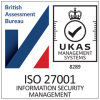Regtech is a now becoming an increasingly familiar concept within Financial Services, but like an ink blot, it is open to many differing interpretations. It is perhaps best to think of Regtech in the context of its more widely known relation, Fintech. As Fintech aims to disrupt existing financial service models, on a smaller scale we can think of Regtech as aiming to disrupt the current way we approach it and embed compliance regulations.
This shared theme of disruption is key, as Regtech solutions should aim to do more than simply digitise existing manual compliance processes, but innovatively look at how regulations and the key theme of treating customers fairly can be fulfilled in a more effective and efficient manner.
This need for innovation in how wealth and investment management firms approach regulations is now more key than ever, as firms prepare in 2017 for a range of new requirements from MiFID II to new data protection rules under GDPR.
Regtech providers can help firms to cope with these challenges in a number of key ways,
- Providing scale across many firms, rather than each having to reinvent the wheel
- Delivering agility via reusable platforms that can be more quickly adapted to new regulations
- Apply cutting edge technology such as machine learning to deliver more focused and proactive monitoring
- Provide additional benefits to clients and staff via differing approaches to regulation

In the client engagement space, we are seeing increasingly innovative solutions appear, to not only help reduce the regulatory burden, but support the front office in providing more pro-active engagement across a wider range of channels. For example, many of the new regulations require additional information to be collected from clients, often via a time consuming re-papering exercise that places an undue burden on clients.
For MiFID II this can include requirements for LEI references for transaction reporting, to additional information on a client’s knowledge and experience to support suitability and appropriate checks. More innovative solutions to these problems move towards a ‘self-service’ capability for online clients, prompting them while inside the wider client portal or app to update their details.
Built to the principles discussed earlier, such tools should be re-useable and configurable, allowing firms to quickly adapt to changing data gathering requirements without having to run costly and time-consuming projects. They should also look to provide benefits to the client, for example recommending reading materials based upon a client’s knowledge gaps. These helps ensure that clients see updating their details as more than just a chore.
Regtech providers can also help provide a more proactive approach to monitoring interactions, while also enhancing the client proposition. At its most basic, this can be deployed to help with the removal of the current qualified exemption for discretionary investment managers around the taping of client calls.
However, this can be further expanded to provide the ability to interact and take instructions from clients in a secure and recorded fashion via new channels such as video conferencing and messaging apps. As the client file builds up with the records of these interactions, machine learning can then be applied to both transcribe spoken conversations, but also then analyse and flag up client files for review based on sentiment or key phrases.
Firms do however need to ensure they can ‘walk before you run’ with Regtech, as without a single version of the truth for client information and holdings (particularly for those firms utilising multiple custodians), the benefits of these tools can be hard to realise. For example, poor data quality makes self-service difficult, while the lack of a consolidated view of client interactions makes a more proactive analysis of treating the customer fairly rules impossible.
Additionally, other challenges await, in particular, the need to consider how solutions cope with complex regulations across multiple jurisdictions, as well as the differing levels of engagement and clarity from each of these jurisdictions regulators. There are positive signs however, for example, the UK FCA’s Project Innovate and its specific engagement with Fintech and Regtech firms, or the recent approval in Switzerland from FINMA for the use of video conferencing as part of a fully digital take-off process.
In summary, Regtech offers firms the ability to do more than simply continuing to apply ‘sticking plasters’ as regulations change, but implement solutions that allow more agility, while also delivering a better overall client experience. However achieving this goal is not without difficulties, and firms, Regtech providers and regulators need to work together to realise these benefits.





